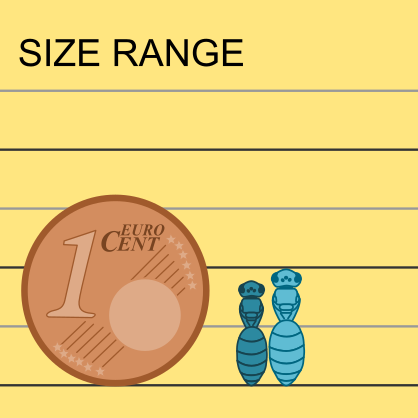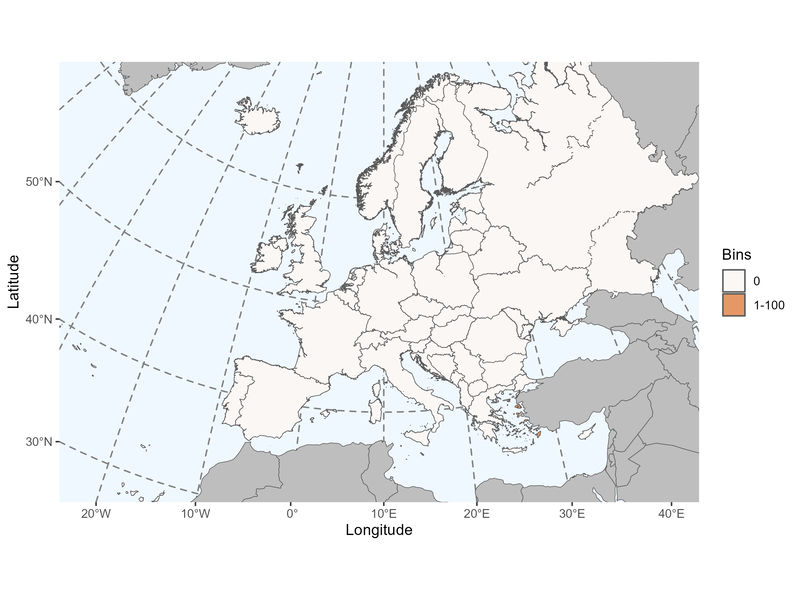Author: Blüthgen, 1955
|
Type species: Halictus prognathus Pérez, 1912, by original designation.
|
Clade: Anthophila
Family: Halictidae Subfamily: Halictinae Tribe: Halictini |
|
Distinctive traits
|
Pictures of distinctive traits.
(Sorry, there is no picture available at this time. If you have some and would like to become a contributor to IDmyBee, please contact us.) |
Morphologically close genera and how to distinguish them:
Thrincohalictus is very rare, restricted to eastern mediterranean islands. It is morphologically close to the much more common genus Halictus.
Halictus females have a truncated clypeus extended downward at each side of labrum as a small, rather sharp, impunctate projection. Males head is less elongated (malar space < 1x flagellum width).
Lasioglossum species have submarginal vein 3 and recurrent vein 2 less visible than submarginal vein 1. Hairs bands on the abdomen are at the basal part of the segments
Thrincohalictus is very rare, restricted to eastern mediterranean islands. It is morphologically close to the much more common genus Halictus.
- Thrincohalictus - Halictus
Halictus females have a truncated clypeus extended downward at each side of labrum as a small, rather sharp, impunctate projection. Males head is less elongated (malar space < 1x flagellum width).
- Thrincohalictus - Lasioglossum
Lasioglossum species have submarginal vein 3 and recurrent vein 2 less visible than submarginal vein 1. Hairs bands on the abdomen are at the basal part of the segments
General comments on Thrincohalictus species identification
There is only one species of Thrincohalictus recorded in Europe.
There is only one species of Thrincohalictus recorded in Europe.
Thrincohalictus species found in Europe (Ghisbain et al. 2023):
Thrincohalictus prognathus (Pérez, 1912)
Thrincohalictus prognathus (Pérez, 1912)
Page contributors:
You noticed a mistake? You have a suggestion to improve this page?
Don't keep it to yourself, contact us and become a contributor to IDmyBee!
- Adrien Perrard (Dec. 2023)
- Adrien Perrard (Dec. 2019)
You noticed a mistake? You have a suggestion to improve this page?
Don't keep it to yourself, contact us and become a contributor to IDmyBee!
References used to write this page:
- Ghisbain, G., Rosa, P., Bogusch, P., Flaminio, S., Le Divelec, R., Dorchin, A., Kasparek, M., Kuhlmann, M., Litman, J., Mignot, M., Müller, A., Praz, C., Radchenko, V.G., Rasmont, P., Risch, S., Roberts, S.P.M., Smit, J., Wood, T.J., Michez, D. & Reverte, S. (2023). The new annotated checklist of the wild bees of Europe (Hymenoptera: Anthophila). Zootaxa, 5327(1), 1-147.
- Michener, C.D. 2007. The Bees of the World, 2nd Edition. The John Hopkins University Press, Baltimore.
- Michez D., Rasmont P., Terzo, M., Vereecken, N. 2019. Abeilles d'Europes. Hymenoptères d'Europes, Volume 1. N.A.P. Editions.
- Nieto, A., Roberts, S. P., Kemp, J., Rasmont, P., Kuhlmann, M., García Criado, M., ... & Michez, D. 2014. European red list of bees. Luxembourg: Publication Office of the European Union, 98.
- Rasmont, P., Devalez, Jelle, Pauly, A., Michez, D. & Radchenko, V.G. 2017. Addition to the checklist of IUCN European wild bees (Hymenoptera: Apoidea). Annales de la Société entomologique de France 53: 17-32.



